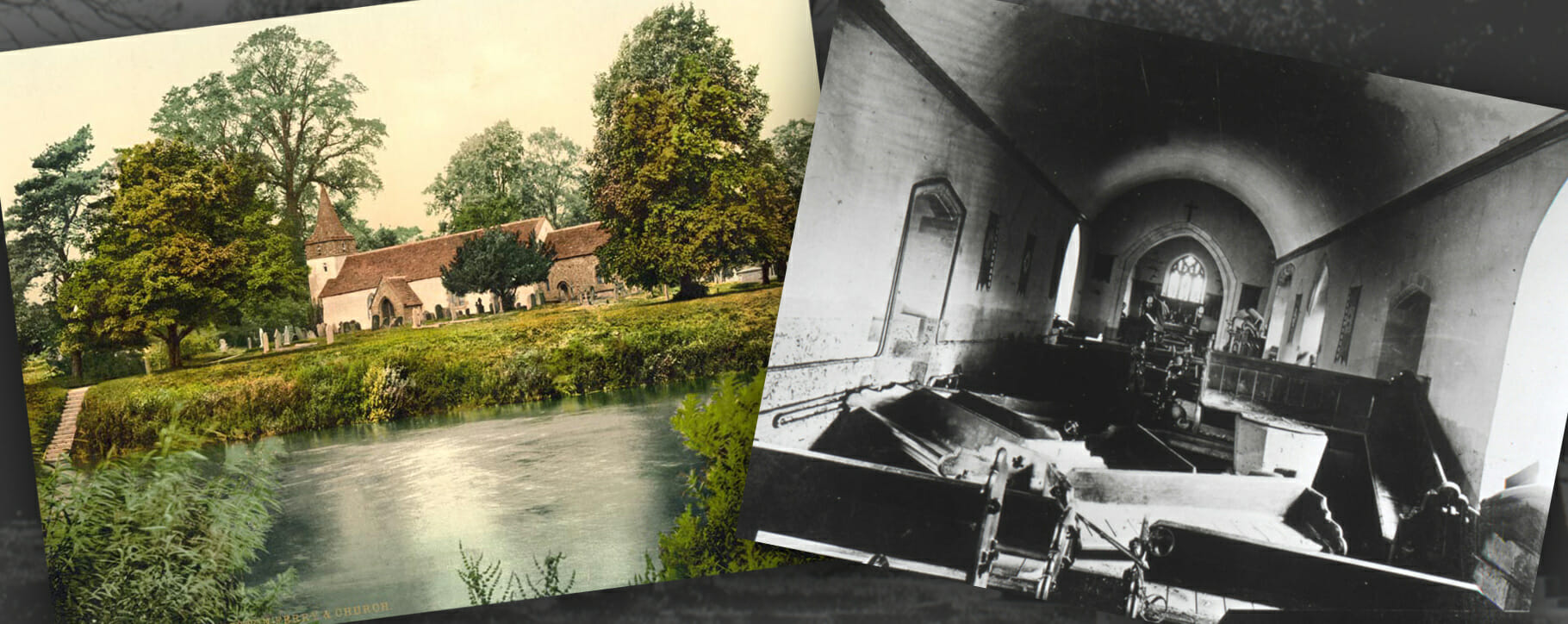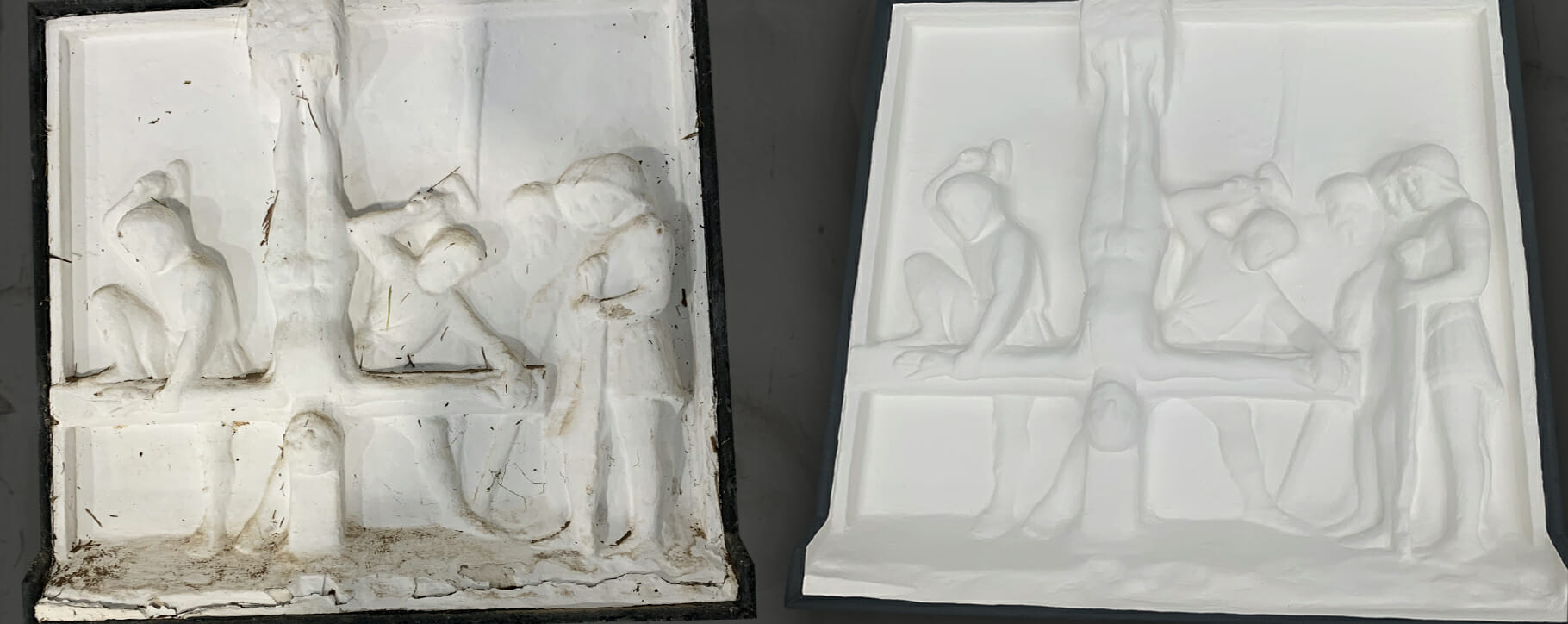St. Peters Church in Monmouth, Wales, faces a constant threat of flooding.The 12th century parish church is situated on the banks of the River Wye and has throughout it’s life suffered from constant and often severe disruption following adverse weather conditions prompting the river to overflow.
The Church Of England building is Grade II listed and features a cross in it’s yard which is both listed and a scheduled monument. With such historic and community importance, the protection and ongoing maintenance of the church is paramount and requires intervention to help it survive the flooding as it becomes more frequent and more extreme.
 Above: St Peters Church in historic photographs, including it’s location next to the river (left) and the damage following a flood (right)
Above: St Peters Church in historic photographs, including it’s location next to the river (left) and the damage following a flood (right)
Although St. Peters floods at least twice a year, it was in 2020 that it experienced the greatest exposure, following heavy rainfall in November 2019 the church required £130,000 in repairs, but was almost immediately hit again in February 2020 by Storm Dennis the day after this was completed. So frequent is the flood damage to the church that a sign inside the building marks the previous flooding depths, with the highest being recorded on 22nd March 1947.
The water levels during Storm Dennis reached above six feet, the second worst in the history of the church. Although the church has a purpose built balcony to keep items out of reach of flooding, the waters quickly entered the building with enough force to move the pews and benches, causing damage to the wooden furniture and precious textiles which were on the ground level.
 Above: floods have become a regular occurance across the UK and put many historic buildings and artworks in danger of deterioration and loss
Above: floods have become a regular occurance across the UK and put many historic buildings and artworks in danger of deterioration and loss
Penny Powdrill, St. Peter’s stand-in vicar, spoke to the local newspaper about the disaster – “When it happened in November we got the fire service in and we were back up and running within a week or so. I think we’ll need more than the fire service this time, I can’t remember many floods at all that have been of this dimension.”
Although the church was assisted by locals following the flood, it required further involvement from disaster specialists and a fast response from conservation experts to save the water damaged items.
 Above: damaged items salvaged from St. Peters church after the flood, including a watercolour, relief artwork and textiles
Above: damaged items salvaged from St. Peters church after the flood, including a watercolour, relief artwork and textiles
This is where our team at Fine Art Restoration Company stepped in, documenting the affected items and quickly transporting them to our clean and dry studio. Not only did this expedite preservation treatments but allowed conservation work to be taken out on the architecture of the building with the benches, pews and important objects out of the way and safe from any further disturbance.
As soon as the flood damaged pieces arrived, our specialists assessed each piece for areas of damage and gave recommendations of treatment. As this was able to go through an insurance claim, it was important that all costs were broken down and the specific issues were noted in a document. This outline of the project would also be helpful for the records of the church and for future conservators to have as evidence of prior repairs. Our team provides full condition reports as required, for more information please click here.
 Above: flood damaged wooden items from St. Peters Church which were salvaged and later restored by our team
Above: flood damaged wooden items from St. Peters Church which were salvaged and later restored by our team
Of the pieces which were in need of restoration treatment, many were wooden objects or artworks. These faced significant risk from the water damage as without treatment their structure could begin to decay from the inside out. Like many of the other items, a set of three wooden statues had been contaminated with brown water – freshwater which has mixed with mud and pollution or toxins from sewage and bins. Not only could the brown water cause deterioration through moisture, but a mixture of toxic or acidic particles could have a severely adverse effect over a long or short course of time.
The recommended treatment for the statues was to clean and remove any deposited dirt and contaminants with tailored solutions, as well as sealing the wood where required and finally reviving the colour of the wood with a matching polish. They would also be waxed for future protection, adding a further barrier to any moisture.
 Above: a selection of church pews which with flood damage from the church, which were later restored by our textile conservators
Above: a selection of church pews which with flood damage from the church, which were later restored by our textile conservators
Several textile pieces were assessed, including altar cloths, cushions, and kneeling pads. It was recommended that a set of 25 kneeling pads, all of which were handmade with a unique woolen embroidery, were to be gently washed in a tailored solution to expel any contaminants and debris from the brown water. The internal cushion of each could then be replaced with a suitable alternative, as well as a new fabric backing to the piece which would eliminate any areas of decay or moisture retention. This would save the important embroidered feature from any future complications and revive their structure following the water damage.
 Above: a plaster relief artwork from St. Peters, before and after restoration by our team – including the removal of contamination and the stabilisation of cracks and surface damage
Above: a plaster relief artwork from St. Peters, before and after restoration by our team – including the removal of contamination and the stabilisation of cracks and surface damage
Following conservation work to the church itself, all salvaged and restored items were returned into their original places. The church reopened its doors in August 2020, allowing the local community to gather once again – not only was this important as a place of worship, but vital following the effect COVID-19 may have had on the congregation in the gap between the disasters and the summer of the same year. A private service was held at the end of August in order to celebrate those who had worked and volunteered to clean and repair the church following Storm Dennis.
How can we help with flood damage restoration?
If you have a project which may benefit from flood damage restoration or storage of precious items, artworks, or furniture during architectural conservation work, please get in touch with our team to arrange professional assessments and assistance.
To get in touch please email us via [email protected] or call 0207 112 7576.






